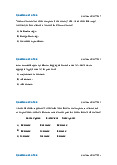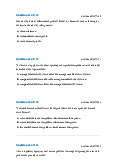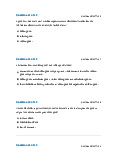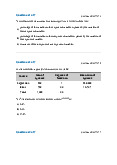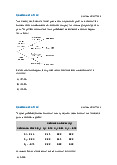

























Preview text:
Question #1 of 81 Question ID: 1376867
A major brokerage house is currently selling an investment product that offers an 8% rate of
return, compounded monthly. Based on this information, it follows that this investment has:
A) a periodic interest rate of 0.667%. B) a stated rate of 0.830%.
C) an eective annual rate of 8.00%. Question #2 of 81 Question ID: 1376863
A stated interest rate of 9% compounded quarterly results in an effective annual rate closest to: A) 9.3%. B) 9.4%. C) 9.2%. Question #3 of 81 Question ID: 1376868
Peter Wallace wants to deposit $10,000 in a bank certificate of deposit (CD). Wallace is
considering the following banks:
Bank A offers 5.85% annual interest compounded annually.
Bank B offers 5.75% annual interest rate compounded monthly.
Bank C offers 5.70% annual interest compounded daily.
Which bank offers the highest effective interest rate and how much? A) Bank B, 5.90%. B) Bank C, 5.87%. C) Bank A, 5.85%. Question #4 of 81 Question ID: 1376921
Nikki Ali and Donald Ankard borrowed $15,000 to help finance their wedding and reception.
The annual payment loan carries a term of seven years and an 11% interest rate.
Respectively, the amount of the first payment that is interest and the amount of the second
payment that is principal are approximately: A) $1,468; $1,702. B) $1,650; $1,468. C) $1,650; $1,702. Question #5 of 81 Question ID: 1376914
Fifty years ago, an investor bought a share of stock for $10. If the stock has experienced 2%
compound annual growth over the period, its price today is closest to: A) $39. B) $51. C) $27. Question #6 of 81 Question ID: 1376923
Sarah Parker is buying a new $25,000 car. Her trade-in is worth $5,000 so she needs to
borrow $20,000. The loan will be paid in 48 monthly installments and the annual interest
rate on the loan is 7.5%. If the first payment is due at the end of the first month, what is Sarah's monthly car payment? A) $483.58. B) $480.57. C) $416.67. Question #7 of 81 Question ID: 1376891
Justin Banks just won the lottery and is trying to decide between the annual cash flow
payment option or the lump sum option. He can earn 8% at the bank and the annual cash
flow option is $100,000/year, beginning today for 15 years. What is the annual cash flow option worth to Banks today? A) $1,080,000.00. B) $855,947.87. C) $924,423.70. Question #8 of 81 Question ID: 1376934
An individual borrows $200,000 to buy a house with a 30-year mortgage requiring payments
to be made at the end of each month. The interest rate is 8%, compounded monthly. What is the monthly mortgage payment? A) $1,468. B) $1,889. C) $1,776. Question #9 of 81 Question ID: 1376925
An investor has the choice of two investments. Investment A offers interest at 7.25%
compounded quarterly. Investment B offers interest at the annual rate of 7.40%. Which
investment offers the higher dollar return on an investment of $50,000 for two years, and by how much?
A) Investment A oers a $122.18 greater return.
B) Investment B oers a $36.92 greater return.
C) Investment A oers a $53.18 greater return. Question #10 of 81 Question ID: 1376881
Paul Kohler inherits $50,000 and deposits it immediately in a bank account that pays 6%
interest. No other deposits or withdrawals are made. In two years, what will be the account
balance assuming monthly compounding? A) $50,500 B) $53,100 C) $56,400 Question #11 of 81 Question ID: 1376911
A local bank offers a certificate of deposit (CD) that earns 5.0% compounded quarterly for
three and one half years. If a depositor places $5,000 on deposit, what will be the value of the account at maturity? A) $5,875.00. B) $5,931.06. C) $5,949.77. Question #12 of 81 Question ID: 1376922
How much should an investor have in a retirement account on his 65th birthday if he wishes
to withdraw $40,000 on that birthday and each of the following 14 birthdays, assuming his
retirement account is expected to earn 14.5%? A) $234,422. B) $274,422. C) $272,977. Question #13 of 81 Question ID: 1376924
The First State Bank is willing to lend $100,000 for 4 years at 12%. Assuming the loan is fully
amortizing repayable in six monthly installments, the first payment is closest to: A) $6,000. B) $32,900. C) $16,100. Question #14 of 81 Question ID: 1376880
If a $45,000 car loan is financed at 12% over 4 years, what is the monthly car payment? A) $1,565.00 B) $1,185.00 C) $985.00 Question #15 of 81 Question ID: 1376896
A firm is evaluating an investment that promises to generate the following annual cash flows: End of Year Cash Flows 1 $5,000 2 $5,000 3 $5,000 4 $5,000 5 $5,000 6 -0- 7 -0- 8 $2,000 9 $2,000
Given BBC uses an 8% discount rate, this investment should be valued at: A) $19,963.00 B) $22,043.00 C) $23,529.00 Question #16 of 81 Question ID: 1376910
Given a 5% discount rate, the present value of $500 to be received three years from today is: A) $400. B) $432. C) $578. Question #17 of 81 Question ID: 1376904
Given investors require an annual return of 12.5%, a perpetual bond (i.e., a bond with no
maturity/due date) that pays $87.50 a year in interest should be valued at: A) $70. B) $1,093. C) $700. Question #18 of 81 Question ID: 1376907
The future value of $10,000 invested for 5 years, if the annual interest rate is 8%,
compounded monthly, is closest to: A) $14,000. B) $14,700. C) $14,900. Question #19 of 81 Question ID: 1376857
Vega research has been conducting investor polls for Third State Bank. They have found the
most investors are not willing to tie up their money in a 1-year (2-year) CD unless they
receive at least 1.0% (1.5%) more than they would on an ordinary savings account. If the
savings account rate is 3%, and the bank wants to raise funds with 2-year CDs, the yield must be at least:
A) 4.5%, and this represents a required rate of return.
B) 4.5%, and this represents a discount rate.
C) 4.0%, and this represents a required rate of return. Question #20 of 81 Question ID: 1376917
Three years from now, an investor will deposit the first of eight $1,000 payments into a
special fund. The fund will earn interest at the rate of 5% per year until the third deposit is
made. Thereafter, the fund will return a reduced interest rate of 4% compounded annually
until the final deposit is made. How much money will the investor have in the fund at the
end of ten years assuming no withdrawals are made? A) $8,872.93. B) $9,251.82. C) $9,549.11. Question #21 of 81 Question ID: 1376877
The future value of $1,000 invested for one year at a rate of interest of 12% compounded monthly is closest to: A) $1,120. B) $1,121. C) $1,127. Question #22 of 81 Question ID: 1376860
Which one of the following statements best describes the components of the required interest rate on a security?
The real risk-free rate, the default risk premium, a liquidity premium and a premium A)
to reect the risk associated with the maturity of the security.
The nominal risk-free rate, the expected ination rate, the default risk premium, a
B) liquidity premium and a premium to reect the risk associated with the maturity of the security.
The real risk-free rate, the expected ination rate, the default risk premium, a
C) liquidity premium and a premium to reect the risk associated with the maturity of the security. Question #23 of 81 Question ID: 1376929
Which of the following statements about compounding and interest rates is least accurate?
On monthly compounded loans, the eective annual rate (EAR) will exceed the A) annual percentage rate (APR).
B) Present values and discount rates move in opposite directions.
All else equal, the longer the term of a loan, the lower will be the total interest you C) pay. Question #24 of 81 Question ID: 1380829
Five years ago, an investor borrowed $5,000 from a financial institution that charged a 6%
annual interest rate, and he immediately took his family to live in Nepal. He made no
payments during the time he was away. When he returned, he agreed to repay the original
loan plus the accrued interest by making five end-of-year payments starting one year after
he returned. If the interest rate on the loan is held constant at 6% per year, what annual
payment must the invstor make in order to retire the loan? A) $1,638.23. B) $1,338.23. C) $1,588.45. Question #25 of 81 Question ID: 1376865
A local bank offers an account that pays 8%, compounded quarterly, for any deposits of
$10,000 or more that are left in the account for a period of 5 years. The effective annual rate
of interest on this account is: A) 4.65%. B) 8.24%. C) 9.01%. Question #26 of 81 Question ID: 1376937
Jim Franklin recently purchased a home for $300,000 on which he made a down payment of
$100,000. He obtained a 30-year mortgage to finance the balance on which he pays a fixed
annual rate of 6%. If he makes regular, fixed monthly payments, what loan balance will
remain just after the 48th payment? A) $186,109. B) $192,444. C) $189,229. Question #27 of 81 Question ID: 1376899
Wortel Industries has preferred stock outstanding that paying an annual dividend of $3.75
per share. If an investor wants to earn a rate of return of 8.5%, how much should he be
willing to pay for a share of Wortel preferred stock? A) $42.10. B) $31.88. C) $44.12. Question #28 of 81 Question ID: 1376862
The real risk-free rate can be thought of as:
A) approximately the nominal risk-free rate plus the expected ination rate.
B) approximately the nominal risk-free rate reduced by the expected ination rate.
C) exactly the nominal risk-free rate reduced by the expected ination rate. Question #29 of 81 Question ID: 1376889
How much would the following income stream be worth assuming a 12% discount rate? $100 received today.
$200 received 1 year from today.
$400 received 2 years from today.
$300 received 3 years from today. A) $810.98. B) $721.32. C) $1,112.44. Question #30 of 81 Question ID: 1376858
Selmer Jones has just inherited some money and wants to set some of it aside for a vacation
in Hawaii one year from today. His bank will pay him 5% interest on any funds he deposits.
In order to determine how much of the money must be set aside and held for the trip, he should use the 5% as a: A) discount rate. B) opportunity cost. C) required rate of return. Question #31 of 81 Question ID: 1376920
Elise Corrs, hedge fund manager and avid downhill skier, was recently granted permission to
take a 4 month sabbatical. During the sabbatical, (scheduled to start in 11 months), Corrs
will ski at approximately 12 resorts located in the Austrian, Italian, and Swiss Alps. Corrs
estimates that she will need $6,000 at the beginning of each month for expenses that
month. (She has already financed her initial travel and equipment costs.) Her financial
planner estimates that she will earn an annual rate of 8.5% during her savings period and an
annual rate of return during her sabbatical of 9.5%. How much does she need to put in her
savings account at the end of each month for the next 11 months to ensure the cash flow
she needs over her sabbatical? Each month, Corrs should save approximately: A) $2,080. B) $2,065. C) $2,070. Question #32 of 81 Question ID: 1376874
If an investment has an APR of 18% and is compounded quarterly, its effective annual rate (EAR) is closest to: A) 19.25%. B) 18.81%. C) 18.00%. Question #33 of 81 Question ID: 1376875
In 10 years, what is the value of $100 invested today at an interest rate of 8% per year, compounded monthly? A) $180.00 B) $216.00 C) $222.00 Question #34 of 81 Question ID: 1376905
What is the present value of $200 to be received one year from now, $300 to be received 3
years from now, and $600 to be received 5 years from now assuming an interest rate of 5%? A) $980.89. B) $919.74. C) $905.87. Question #35 of 81 Question ID: 1376909
An investment product promises to pay a lump sum of $25,458 at the end of 9 years. If an
investor feels this investment should produce a rate of return of 14%, compounded
annually, the present value is closest to: A) $9,426.00 B) $7,618.00 C) $7,829.00 Question #36 of 81 Question ID: 1376878
What is the maximum price an investor should be willing to pay (today) for a 10 year annuity
that will generate $500 per quarter (such payments to be made at the end of each quarter),
given he wants to earn 12%, compounded quarterly? A) $6,440 B) $11,300 C) $11,557 Question #37 of 81 Question ID: 1376892
The future value a 10-year annuity paying an annual sum of $10,000 at the end of each year
given a discount rate of 10% would be: A) $159,374.00 B) $175,312.00 C) $100,000. Question #38 of 81 Question ID: 1376906
What is the maximum an investor should be willing to pay for an annuity that will pay out
$10,000 at the beginning of each of the next 10 years, given the investor wants to earn 12.5%, compounded annually? A) $52,285. B) $55,364. C) $62,285. Question #39 of 81 Question ID: 1376871
Other things equal, as the number of compounding periods increases, what is the effect on
the effective annual rate (EAR)? A) EAR increases. B) EAR decreases. C) EAR remains the same. Question #40 of 81 Question ID: 1376913
An investor makes 48 monthly payments of $500 each beginning today into an account that
will have a value of $29,000 at the end of four years. The stated annual interest rate is closest to: A) 10.00%. B) 9.00%. C) 9.50%. Question #41 of 81 Question ID: 1376872
A local bank advertises that it will pay interest at the rate of 4.5%, compounded monthly, on
regular savings accounts. What is the effective rate of interest that the bank is paying on these accounts? A) 4.50%. B) 4.65%. C) 4.59%. Question #42 of 81 Question ID: 1376873
As the number of compounding periods increases, what is the effect on the EAR? EAR: A) does not increase.
B) increases at a decreasing rate.
C) increases at an increasing rate. Question #43 of 81 Question ID: 1376869
A local loan shark offers 4 for 5 on payday. What it involves is that you borrow $4 from him
and repay $5 on the next payday (one week later). What would the stated annual interest
rate be on this loan, with weekly compounding? Assuming 52 weeks in one year, what is the
effective annual interest rate on this loan? Select the respective answer choices closest to your numbers. A) 1,300%; 10,947,544%. B) 25%; 1,300%. C) 25%; 300%. Question #44 of 81 Question ID: 1376932
It will cost $20,000 a year for four years when an 8-year old child is ready for college. How
much should be invested today if the child will make the first of four annual withdrawals 10-
years from today? The expected rate of return is 8%. A) $33,138. B) $30,683. C) $66,243. Question #45 of 81 Question ID: 1376901
If $2,000 a year is invested at the end of each of the next 45 years in a retirement account
yielding 8.5%, the amount the investor will have after 45 years is closest to: A) $900,000. B) $180,000. C) $270,000. Question #46 of 81 Question ID: 1376882
Renee Fisher invests $2,000 each year, starting one year from now, in a retirement account.
If the investments earn 8% or 10% annually over 30 years, the amount Fisher will accumulate is closest to: 8% 10% A) $245,000 $360,000 B) $225,000 $330,000 C) $225,000 $360,000 Question #47 of 81 Question ID: 1376859
Wei Zhang has funds on deposit with Iron Range bank. The funds are currently earning 6%
interest. If he withdraws $15,000 to purchase an automobile, the 6% interest rate can be best thought of as a(n): A) discount rate. B) nancing cost. C) opportunity cost. Question #48 of 81 Question ID: 1376870
What is the effective annual rate if the stated rate is 12% compounded quarterly? A) 11.49%. B) 57.35%. C) 12.55%. Question #49 of 81 Question ID: 1376930
A recent ad for a Roth IRA includes the statement that if a person invests $500 at the
beginning of each month for 35 years, they could have $1,000,000 for retirement. Assuming
monthly compounding, what annual interest rate is implied in this statement? A) 7.411%. B) 7.625%. C) 6.988%. Question #50 of 81 Question ID: 1376895
What is the present value of a 10-year, $100 annual annuity due if interest rates are 0%? A) No solution. B) $900. C) $1,000. Question #51 of 81 Question ID: 1376898
Suppose you are going to deposit $1,000 at the start of this year, $1,500 at the start of next
year, and $2,000 at the start of the following year in a savings account. How much money
will you have at the end of three years if the rate of interest is 10% each year? A) $4,000.00. B) $5,346.00. C) $5,750.00. Question #52 of 81 Question ID: 1376935
John is getting a $25,000 loan, with an 8% annual interest rate to be paid in 48 equal monthly
installments. If the first payment is due at the end of the first month, the principal and
interest values for the first payment are closest to: Principal Interest A) $410.32 $200.00 B) $443.65 $200.00 C) $443.65 $166.67 Question #53 of 81 Question ID: 1376912
The value in 7 years of $500 invested today at an interest rate of 6% compounded monthly is closest to: A) $760. B) $750. C) $780. Question #54 of 81 Question ID: 1376926
Steve Hall wants to give his son a new car for his graduation. If the cost of the car is $15,000
and Hall finances 80% of the value of the car for 36 months at 8% annual interest, his monthly payments will be: A) $376. B) $289. C) $413. Question #55 of 81 Question ID: 1376936
Natalie Brunswick, neurosurgeon at a large U.S. university, was recently granted permission
to take an 18-month sabbatical that will begin one year from today. During the sabbatical,
Brunswick will need $2,500 at the beginning of each month for living expenses that month.
Her financial planner estimates that she will earn an annual rate of 9% over the next year on
any money she saves. The annual rate of return during her sabbatical term will likely
increase to 10%. At the end of each month during the year before the sabbatical, Brunswick should save approximately: A) $3,505.00 B) $3,356.00 C) $3,330.00 Question #56 of 81 Question ID: 1376897
Compute the present value of a perpetuity with $100 payments beginning four years from
now. Assume the appropriate annual interest rate is 10%. A) $751. B) $1,000. C) $683. Question #57 of 81 Question ID: 1376933
Marc Schmitz borrows $20,000 to be paid back in four equal annual payments at an interest
rate of 8%. The interest amount in the second year's payment would be: A) $1116.90. B) $1244.90. C) $6038.40. Question #58 of 81 Question ID: 1376902
An investor wants to receive $1,000 at the beginning of each of the next ten years with the
first payment starting today. If the investor can earn 10 percent interest, what must the
investor put into the account today in order to receive this $1,000 cash flow stream? A) $6,145. B) $7,145. C) $6,759. Question #59 of 81 Question ID: 1376888
A loan of $15,000 is to be paid off in monthly payments over 5 years at 12% annual interest.
What is the amount of each payment? A) $334. B) $4,161. C) $1,802. Question #60 of 81 Question ID: 1376884
If 10 equal annual deposits of $1,000 are made into an investment account earning 9%
starting today, how much will you have in 20 years? A) $42,165. B) $39,204. C) $35,967. Question #61 of 81 Question ID: 1376931
An investor who requires an annual return of 12% has the choice of receiving one of the following:
Option A: 10 annual payments of $1,225.00 to begin at the end of one year.
Option B: 10 annual payments of $1,097.96 beginning immediately.
Which option has the highest present value (PV) and approximately how much greater is it than the other option?
A) Option A's PV is $42 greater than option B's.
B) Option B's PV is $114 greater than option A's.
C) Option B's PV is $27 greater than option A's. Question #62 of 81 Question ID: 1376903
An investor purchases a 10-year, $1,000 par value bond that pays annual coupons of $100. If
the market rate of interest is 12%, what is the current market value of the bond? A) $1,124. B) $950. C) $887. Question #63 of 81 Question ID: 1376885
An annuity will pay eight annual payments of $100, with the first payment to be received
three years from now. If the interest rate is 12% per year, what is the present value of this annuity? The present value of:
a lump sum discounted for 3 years, where the lump sum is the present value of an A)
ordinary annuity of 8 periods at 12%.
a lump sum discounted for 2 years, where the lump sum is the present value of an B)
ordinary annuity of 8 periods at 12%.
C) an ordinary annuity of 8 periods at 12%. Question #64 of 81 Question ID: 1376864
A stated annual interest rate of 9% compounded semiannually results in an effective annual rate closest to: A) 8.81%. B) 18.81%. C) 9.2%. Question #65 of 81 Question ID: 1376876
Assuming an annual rate of interest of 11% compounded quarterly, the future value of
$8,000 invested for two years is closest to: A) $9,760. B) $9,857. C) $9,939. Question #66 of 81 Question ID: 1376927
Lois Weaver wants to accumulate $1.5 million in a retirement fund when she retires in 30
years. If Weaver can earn a 9% rate of return on her investments, the amount she must
invest at the end of each year for 30 years to reach her goal is closest to: A) $40,000. B) $11,000. C) $29,000. Question #67 of 81 Question ID: 1376900
Assuming a discount rate of 10%, which stream of annual payments has the highest present value? A) -$100 -$100 -$100 $500 B) $20 -$5 $20 $110 C) $110 $20 $10 $5 Question #68 of 81 Question ID: 1376894
An investor will receive an annuity of $5,000 a year for seven years. The first payment is to
be received 5 years from today. If the annual interest rate is 11.5%, what is the present value of the annuity? A) $23,185.00 B) $13,453.00 C) $15,000.00 Question #69 of 81 Question ID: 1376908
A $500 investment offers a 7.5% annual rate of return. How much will it be worth in four years? A) $892. B) $668. C) $650. Question #70 of 81 Question ID: 1376879
Jamie Morgan needs to accumulate $2,000 in 18 months. If she can earn 6% at the bank,
compounded quarterly, how much must she deposit today? A) $1,829.08. B) $1,832.61. C) $1,840.45. Question #71 of 81 Question ID: 1376866
Which of the following is the most accurate statement about stated and effective annual interest rates?
A) The stated rate adjusts for the frequency of compounding.
B) The stated annual interest rate is used to nd the eective annual rate.
So long as interest is compounded more than once a year, the stated annual rate C)
will always be more than the eective rate. Question #72 of 81 Question ID: 1376883
Bill Jones is creating a charitable trust to provide six annual payments of $20,000 each,
beginning next year. How much must Jones set aside now at 10% interest compounded
annually to meet the required disbursements? A) $95,815.74. B) $154,312.20. C) $87,105.21. Question #73 of 81 Question ID: 1376915
Given an 8.5% discount rate, an asset that generates cash flows of $10 in Year 1, –$20 in
Year 2, $10 in Year 3, and is then sold for $150 at the end of Year 4, has a present value of: A) $135.58. B) $108.29. C) $163.42. Question #74 of 81 Question ID: 1376886
An annuity will pay eight annual payments of $100, with the first payment to be received one
year from now. If the interest rate is 12% per year, what is the present value of this annuity? A) $556.38. B) $1,229.97. C) $496.76. Question #75 of 81 Question ID: 1376928
Optimal Insurance is offering a deferred annuity that promises to pay 10% per annum with
equal annual payments beginning at the end of 10 years and continuing for a total of 10
annual payments. For an initial investment of $100,000, the amount of the annual payments will be closest to: A) $38,375. B) $25,937. C) $42,212. Question #76 of 81 Question ID: 1376893
If $2,500 is invested at the end of each year for the next 10 years, earning 15% interest
compounded annually, the value at the beginning of the eleventh year is be closest to: A) $60,870. B) $50,760. C) $58,380. Question #77 of 81 Question ID: 1376918
A successful investor has decided to set up a scholarship fund for deserving students at her
alma mater. Her plan is for the fund to be capable of awarding $25,000 annually in
perpetuity. The first scholarship is to be awarded and paid out exactly four years from today.
The funds will be deposited into an account immediately and will grow at a rate of 4%,
compounded semiannually, for the foreseeable future. How much money must the investor
donate today to fund the scholarship? A) $574,253. B) $528,150. C) $549,487. Question #78 of 81 Question ID: 1376890
Concerning an ordinary annuity and an annuity due with the same payments and positive
interest rate, which of the following statements is most accurate?
A) The present value of the ordinary annuity is greater than an annuity due. B) There is no relationship.
C) The present value of the ordinary annuity is less than an annuity due. Question #79 of 81 Question ID: 1376887
Given the following cash flow stream: End of Year Annual Cash Flow 1 $4,000 2 $2,000 3 -0- 4 -$1,000
Using a 10% discount rate, the present value of this cash flow stream is: A) $4,606.00 B) $3,636.00 C) $3,415.00 Question #80 of 81 Question ID: 1376861
T-bill yields can be thought of as:
A) nominal risk-free rates because they contain an ination premium.
B) nominal risk-free rates because they do not contain an ination premium.
C) real risk-free rates because they contain an ination premium. Question #81 of 81 Question ID: 1376916
A share of George Co. preferred stock is selling for $65. It pays a dividend of $4.50 per year
and has a perpetual life. The rate of return it is offering its investors is closest to: A) 4.5%. B) 14.4%. C) 6.9%.
